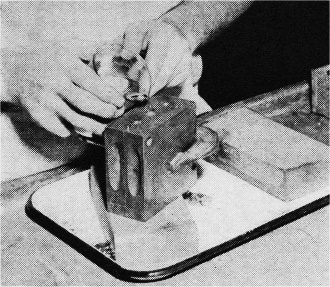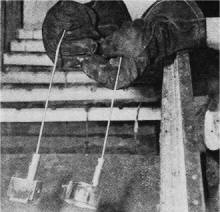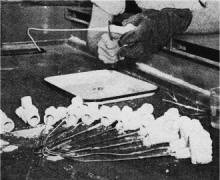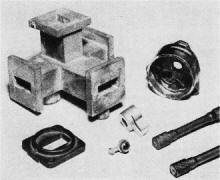|
July 1949 Popular Science
 [Table of Contents] [Table of Contents]
Wax nostalgic about and learn from the history of early
electronics. See articles from
Popular
Science, published 1872-2021. All copyrights hereby acknowledged.
|
As with the health hazards
of smoking, in 1949 when this "Frozen Mercury Shapes Molds" article appeared in
Popular Science magazine, the severe harm possible from ingestion or
absorption of various forms of mercury were not well-established. The history of
determination of
physiological effects of mercury, both elemental and organic,
is abundantly available on the Web, so I won't attempt to replicate it here.
Suffice it to say that except under strictly controlled processes, the use of
mercury as an agent for forming casting molds would never be done nowadays. Wax
and Styrofoam are commonly used materials for the "lost-" technique of molding
whereby a solid of easily liquefied material is a "positive" form encased by a
secondary material - often sand or plastic - and then removed after the
"negative" form has set (become solid). A "refractory material," as mentioned
here, is one that remains solid at high temperatures. Here is a 1963 patent for
mercury molding.
Frozen Mercury Shapes Molds

Mercury replaces wax in new version of "lost-wax" casting process. Poured as
a liquid into master mold, above, it then is frozen solid in a "cold tank" by immersing
mold in a refrigerant.
Solid mercury metal is one of industry's newest and chilliest materials. Made
by cooling quicksilver past its 40-below-zero freezing point, it now replaces wax
in precision casting. Applied in the Sperry Gyroscope Co. plant at Great Neck, N.Y., the method yields smoother and more accurate parts of aluminum and stainless
steel.
Precision casting turns out quantities of metal parts of complicated shape, or
of hard-to-machine alloys, with the advantage of a minimum of machining. The standard,
time-honored "lost-wax" process duplicates a steel or brass master pattern by making,
first, a master mold and, then, individual patterns of wax. Next, these are coated
with refractory material, and the wax is melted out, to make individual molds. Molten,
metal is poured into these molds to cast the parts, which are recovered by breaking
away the molds. The patented new Mercast™ process follows the same principles.
Filled with liquid mercury, the master mold goes into a fluid refrigerant chilled
with dry ice to -76° F., yielding a solid pattern of frozen mercury. Taken from
the mold, this is dipped in a similarly cooled liquid mix of refractory material,
which dries and hardens around it to form the final mold. Then the mercury is allowed
to melt and run out. It is reclaimed for reuse.
|

Solid-mercury precision patterns above, removed from master molds. are handled
by frozen-in wire rods and kept in cold until used. Frozen mercury looks like lead
and is as hard.
|

Refractory molds, formed by dipping in liquid mix and drying in cold, are cut
open and mercury is allowed to melt and run out. It flows down sloping table top
to drain for recovery.
|

Precision castings of complex shapes, above, were made by highly accurate new
Mercast™ process. In parts up to 1 1/2-in. size, it will hold dimensions within
a tolerance of 0.003 inch.
|
Posted
|













